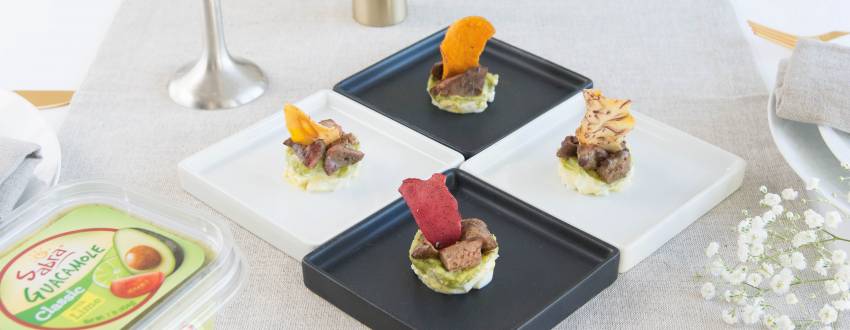PLEASE NOTE: Because there are so many unknowns regarding the behavior of the virus that causes COVID-19, the purpose of this article is only to share the currently available information about grocery shopping safely during the COVID-19 pandemic — and not to give out scientific or medical advice.
Use your discretion when following the recommendations. If you’re unsure, ask a medical professional.
Also, please be aware that all the information is current as of the publication date of this article. Because of the constantly changing information, we cannot guarantee that the recommendations will remain the same at a future date.
______________________________________________________________________
Once upon a time, grocery shopping was kind of fun.
You could peruse the labels of new products, plan recipes in your mind as you sauntered down the aisles, and simply enjoy the respite from your regular routine.
But with the COVID-19 pandemic at hand, those days are gone.
Forget about fun. Now, the grocery shopping experience can range from mildly stressful to utterly panic-inducing.
Should I go or shouldn’t I go? Do I need a mask and gloves? Am I standing 6 feet away from that person? Is that person coughing? Is every surface in this store swarming with coronavirus? Can I even bring this food into my home?
The thing about COVID-19 is there are so many unknowns. And it seems like the facts are changing by the day.
So, to subdue the panic, we gathered the most recent grocery shopping and food safety recommendations so you can be fully informed about the currently-advised best practices.
What we know about: Transmission
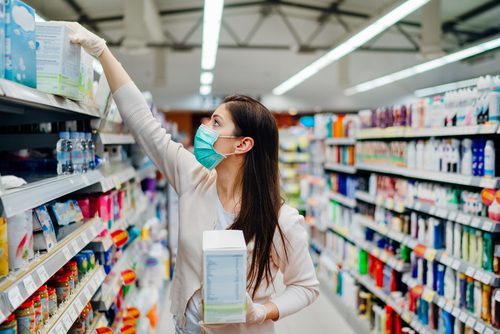
According to the Centers for Disease Control and Prevention:
COVID-19 is thought to spread mainly through close contact from person-to-person in respiratory droplets from someone who is infected.
What this means for grocery shopping:
Because the primary mode of COVID-19 transmission is person-to-person spread, the #1 safety concern when shopping is the risk of coming into contact with others.
There is no fail-safe way to eradicate the possibility of being infected or infecting others. However, staying at home is the best way to minimize risk. Therefore, the ideal way to get groceries is to have them delivered to your home.
If home delivery is not a possibility, you can take precautions when going to the grocery store. (See “Guidelines for in-store shopping” below for more precautions on grocery shopping.)
What we know about: Food safety
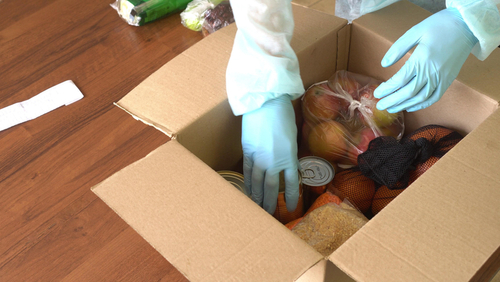
According to the Centers for Disease Control and Prevention:
Currently, there is no evidence to support transmission of COVID-19 associated with food…
It may be possible that a person can get COVID-19 by touching a surface or object, like a packaging container, that has the virus on it and then touching their own mouth, nose, or possibly their eyes, but this is not thought to be the main way the virus spreads.
In general, because of poor survivability of these coronaviruses on surfaces, there is likely very low risk of spread from food products or packaging.
What this means for grocery shopping:
The likelihood of COVID-19 spreading through food or food packaging is very low.
However, some experts recommend taking extra precautions, especially if a member of your household is in an at-risk category for infection. (See “Guidelines for unpacking groceries” below for more precautions on handling food and food packaging.)
What we know about: Virus lifespan
According to a Cleveland Clinic article, here’s how long the virus typically lasts on varying surfaces:
- Glass – 5 days
- Wood – 4 days
- Plastic & stainless steel – 3 days
- Cardboard – 24 hours
- Copper surfaces – 4 hours
Additionally, according to this Cleveland Clinic article, “…the amount of live virus decreases over time on surfaces. So the risk of infection from touching something that had the virus on it for a few days would lessen.”
What this means for grocery shopping:
If you’re concerned about the virus living on the food or food packaging you bring home, the best way to handle this is to let your non-perishables sit unused until the virus completely dies off.
For example, since the virus can live on cardboard for up to 24 hours, if you leave a just-purchased cereal box in your car trunk for 24 hours, you can then use it without any further sanitizing.
Guidelines for home delivery
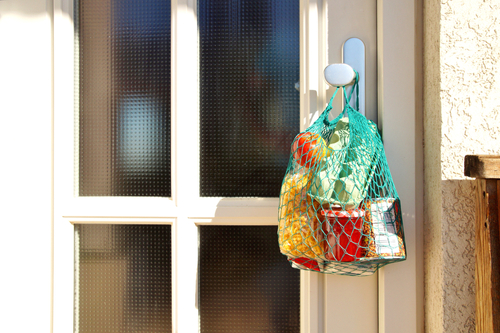
The best way to minimize risk is to limit contact with other people. If you’re getting groceries or take-out food delivered, follow these guidelines:
- Have the delivery person leave the groceries at your door
- Pay and tip electronically
- Wash your hands after handling the delivery
- As an added precaution you can dispose of the delivery bags and containers, and repack the food into clean containers
- See “Guidelines for unpacking groceries” below for more precautions on handling food and food packaging
Guidelines for in-store shopping
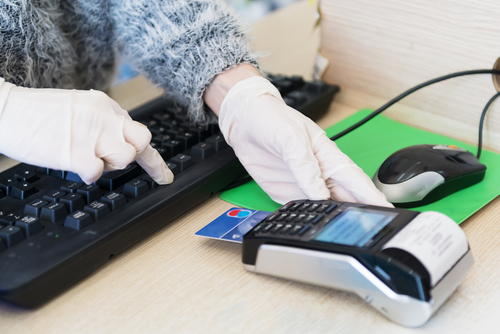
All trips outside your home involve some risk. If you do have to go out to do your food shopping, try to go as infrequently as possible.
Here are some other precautions to follow:
- Have one person per household do the shopping (definitely don’t bring along kids)
- Shop during off-peak hours (Studies show that the least foot traffic in stores is early morning. Busiest hours are between 3-5pm.)
- Wear a face mask
- If you do choose to wear gloves, be aware that they are not a substitute for social distancing, wearing a mask, and proper hand hygiene (Read more on gloves here.)
- Maintain a 6-foot distance from other shoppers
- Wipe off high-touch surfaces, such as the shopping cart handle, before and after shopping
- Touch only the items you intend to buy
- Make a list before you shop
- Use a paper shopping list (instead of your phone)
- Pay by phone or credit card (not cash)
- Apply hand sanitizer on your hands before entering your car
- Wash your hands upon entering your home
Guidelines for unpacking groceries
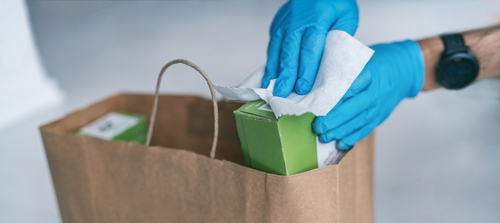
Whether your groceries were delivered or you purchased them yourself in-store, there is still the question of bringing them into your home.
So — can groceries harbor COVID-19, and do you need to disinfect them upon bringing them inside your house?
The answer is unclear.
According to the CDC, the likelihood of COVID-19 spreading through food or food packaging is very low.
However, a TIME magazine article quotes Jared Baeten, the vice dean of the School of Public Health, who says, “For complete risk reduction, you might want to clean off your groceries…That would take the risk from already extremely small, to extremely smaller or nothing.”
If you want to be extra-cautious, follow these guidelines when bringing groceries into your home:
Option #1 — The leave-it-out method
Before bringing non-perishables into your home, let them sit unused (in the trunk of the car, on the porch, or in the garage) for 72 hours. Because the amount of live virus on surfaces decreases over time, it seems most likely that any virus that may have been present on the items will be inactive by that point.
Option #2 — The sanitization method
If you choose to sanitize your groceries, follow the method popularized by Dr. Jeffrey VanWingen. (See the full video here.)
The process of sanitizing your groceries will depend on the material of each item.
To sanitize:
- Fresh fruit and vegetables
Wash very well with water (many experts do not recommend soap, as it can be toxic if ingested). If you do choose to use soap, be sure to completely wash off any soap residue.
- Items in heavy-duty plastic bags (such as frozen vegetables, snacks, etc.)
Wipe down with a paper towel soaked in disinfectant
- Items covered in plastic wrap (such as poultry and meat)
Open the wrap and repackage the food into a new container or plastic baggie.
- Items in cardboard boxes (such as cereal, frozen pizza)
Discard the outer cardboard box. The inner plastic should be safe as it most likely had not been handled by any person in at least a few days.
After you put away all the groceries, be sure to disinfect all the surfaces that were in contact with the food and shopping bags (such as countertops, sinks, etc.). Lastly, don’t forget to wash your hands well.
______________________________________________________________________
Because of the uncertainties surrounding COVID-19, there is so much conflicting information going around. However, everyone can agree on these key points: Wash your hands often, stay home as much as possible, and practice social distancing.
G-d willing, the time will come again when the grocery shopping experience will be an enjoyable and healthy one for everyone involved!





